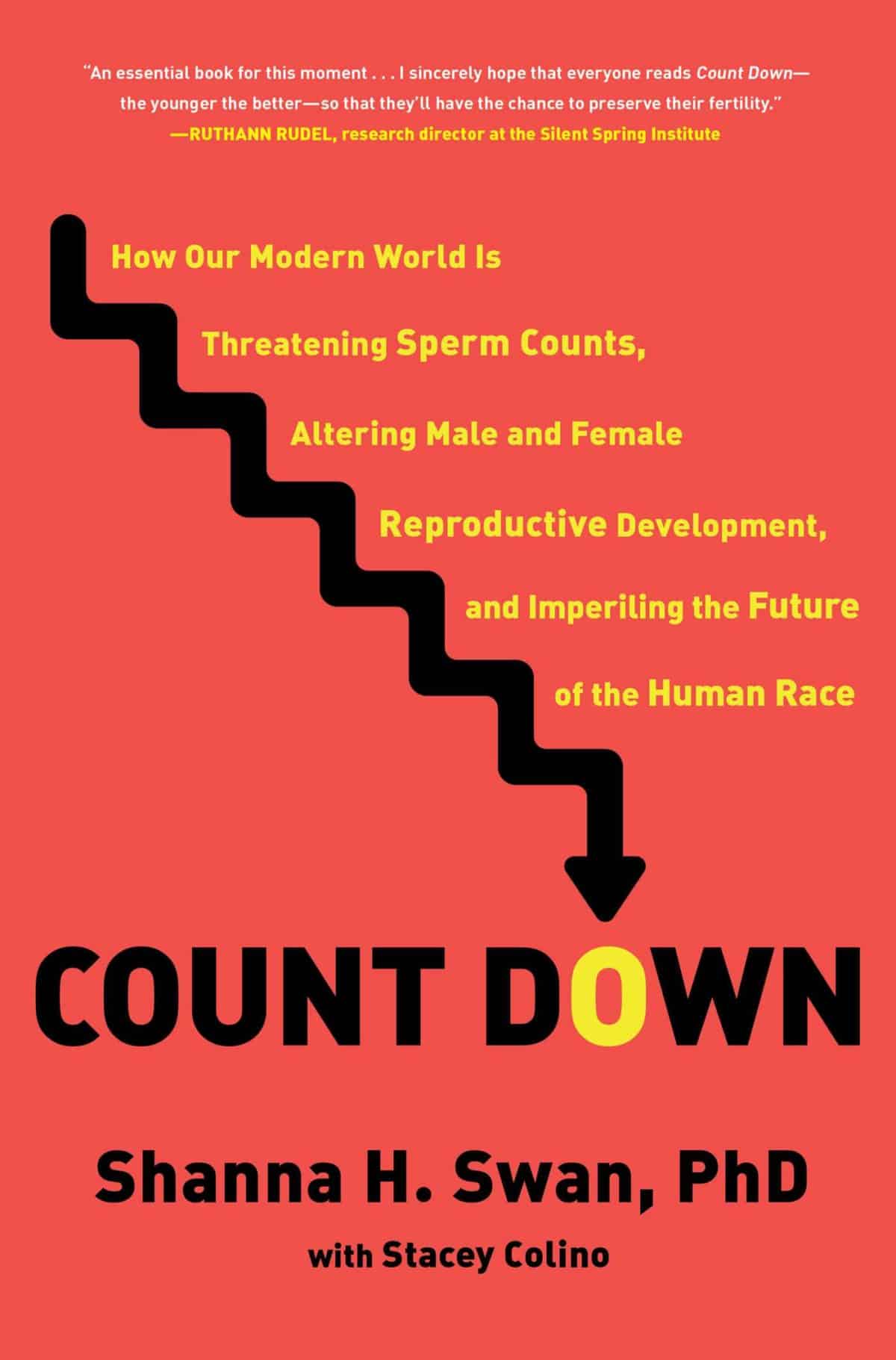In Euripides’ “Medea,” the upsetting of nature foreshadows horror and destruction. “Backward to their sources flow the streams of holy rivers,” the chorus sings. “And the order of all things is reversed.” Shanna H. Swan’s “Count Down: How Our Modern World Is Threatening Sperm Counts, Altering Male and Female Reproductive Development, and Imperiling the Future of the Human Race,” calls to mind such images of dysfunction. In it, Swan contends that fertility has dropped significantly over the past 40 years, not just among humans but across the animal world.

BOOK REVIEW — “Count Down: How Our Modern World Is Threatening Sperm Counts, Altering Male and Female Reproductive Development, and Imperiling the Future of the Human Race,” by Shanna H. Swan (Scribner, 298 pages).
Swan, a respected epidemiologist and professor of environmental medicine and public health at Mount Sinai’s Icahn School of Medicine, has been conducting research in this field since the 1980s. This expertise is what makes the book so powerful, granting her authority to take dozens of disparate research findings and build them into a single persuasive narrative.
The book grew from a 2017 paper in which Swan and her co-authors observed that human sperm counts had dropped by around 50 percent to roughly 60 percent between 1973 and 2011. This dramatic assertion sparked a flurry of media headlines along the lines of “Sperm Counts of Western Men Plummeting, Analysis Finds,” and “The Infertility Crisis Is Beyond Doubt. Now Scientists Must Find the Cause.”
“Count Down” is filled with worrying data you may immediately want to tweet about or send to friends. Swan sketches the backdrop to that 2017 paper and offers explanations for why fertility is falling. Among the many potential culprits — which also include obesity, unhealthy lifestyles, and delayed parenthood — one comes to the fore for Swan: our exposure to chemical compounds, particularly phthalates, which make plastics flexible and give shampoos their creamy consistency. Phthalates are endocrine-disrupting chemicals (EDCs) that alter the hormonal systems regulating human health. Depressingly, they are called “everywhere chemicals” — and are present across the spectrum of our daily lives.
Not only are men’s sperm counts and the quality of semen affected; testosterone levels are falling, erectile dysfunction is occurring among younger men, and libidos are dwindling. The number of boys born with undescended testicles — a condition connected with exposure to EDCs during the first trimester of pregnancy — inexplicably almost doubled in the United Kingdom over a 50-year period, and practically quadrupled in Denmark, Swan reports. Globally, girls are reaching puberty earlier. Women are losing good eggs at younger ages than before, and miscarriage rates are rising. Lest we think this is just about reproduction, there is evidence that chemical exposure affects fetuses’ developing brains, and may be linked to certain cancers. “Infertility is linked to an increased risk of certain diseases and earlier death in both men and women,” Swan explains.
The repercussions for other species are significant, according to Swan. The hardest chapter to read is on declining fertility in animals. Swan outlines how scientists are finding polar bears with low testosterone levels, seals in the Baltic Sea with uterine fibroids, and female sea-snails that developed male sex organs after exposure to under-water chemicals. “There’s been a rise of abnormal genitals in wildlife, including unusually small penises in alligators, panthers, and mink, as well as an increase in fish, frogs, birds, and snapping turtles that have both male and female gonads or ambiguous genitalia,” she writes.
Swan’s often breezy tone tempers this apocalyptic vision, but she leaves little doubt about the situation’s urgency. How have we gotten to this point? The United States is largely doing nothing; and news that the European Commission is “phasing out” some of the more poisonous substances from commercial use is hardly more reassuring. With more than 85,000 commercial chemicals in circulation, regulation remains light, and many products people assume are safe have simply never been tested.
In addition, Swan argues that the concepts used to determine harm are outdated. The idea that higher doses are the most toxic to humans underlies most regulation in Europe and the U.S.; but in some cases, exposure to lower doses over prolonged periods is just as harmful but more insidious, she writes. And these different effects might not emerge through testing that focuses on high-dose exposure. “The truth is,” she writes, “current testing protocols are not adequate to protect public health because they make unfounded assumptions about the nature of the risk that EDCs, in particular, pose to human health.”
Her argument has some critics. Reproductive problems are often multifactorial, making it devilishly hard to prove a causal link between a person’s lifestyle or exposure to chemicals and their infertility. Swan acknowledges this complexity. She herself was a skeptic when reports of a dramatic drop in sperm counts were first published in 1992, but says she became convinced after spending months combing the data and taking potential biases (such as changing lab techniques for counting sperm) into account.
“Count Down” was co-written with Stacey Colino, a journalist Swan met in the media whirl after her 2017 article, and the book is clearly focused on science communication. Everything is explained — the difference between sexuality and gender identity, the use of gender-neutral pronouns, or the workings of a woman’s menstrual cycle. At times it ranges too widely, becoming a primer on everything to do with gender and fertility. The tone is bloggy and familiar. Sperm are referred to as “swimmers,” and acronyms like “BTW” pop up in footnotes.
However, the chatty register signifies a passionate wish to reach as wide an audience as possible. And although the painstaking step-by-step descriptions can feel simplistic at first, they become clarifying and informative as the discussion gets more technical.
Toward the end, Swan conducts a tour of an average house, pointing to where the toxins reside. It’s a clever conceit because it both illustrates the ubiquity of these substances and offers practical tips on removing them. She shows how chemicals are layered throughout our personal spaces, most plentiful in kitchens and bathrooms but also in carpets, kids’ toys, mothballs, makeup, and particles of dust.
Avoiding them is neither easy nor affordable. Swan makes a strong case for a new approach to regulation that would shift the burden of proof from the public to manufacturers. She also calls out the practice of “regrettable substitution,” when one dangerous chemical has been banned, and another is proposed and approved— only to be shown years later (after the publication of research costing millions of dollars and taking scientists decades to carry out) to be just as harmful as the one it replaced, or even more so.
The book offers a few crumbs of hope for dispirited readers. Bald eagles were once decimated by exposure to DDT through contaminated fish. The chemical weakened the birds’ egg shells so that when the mother eagle tried to sit on them for incubation, they would crack and break. But when DDT was banned, the species recovered, and while in 1963, only 417 breeding pairs remained, 10,000 pairs now grace America’s skies.
“Count Down” is billed by its publisher as a “Silent Spring” for our era. In style, it cannot compete with the eloquence of Rachel Carson, who warned back in 1962 of pesticides, “elixirs of death,” being sprayed across the fields. Its message, though, is just as compelling. As Swan observes: “Reproductive abnormalities, fertility challenges, and a higher risk of chronic diseases aren’t acquired traits that any parent wants to pass along to his or her children. But our modern world has made it increasingly difficult to avoid these risks.”
Frieda Klotz is a journalist based in Brussels covering culture, health, and reproductive medicine. Her writing has appeared in the Guardian, Irish Times, Al Jazeera America, Mosaic Science and other outlets. She has reported on donor conception for Irish national radio, and on male infertility for Undark.











Comments are automatically closed one year after article publication. Archived comments are below.
Good article. Worrying for everyone.
“It’s a clever conceit because..”
should this be concept?